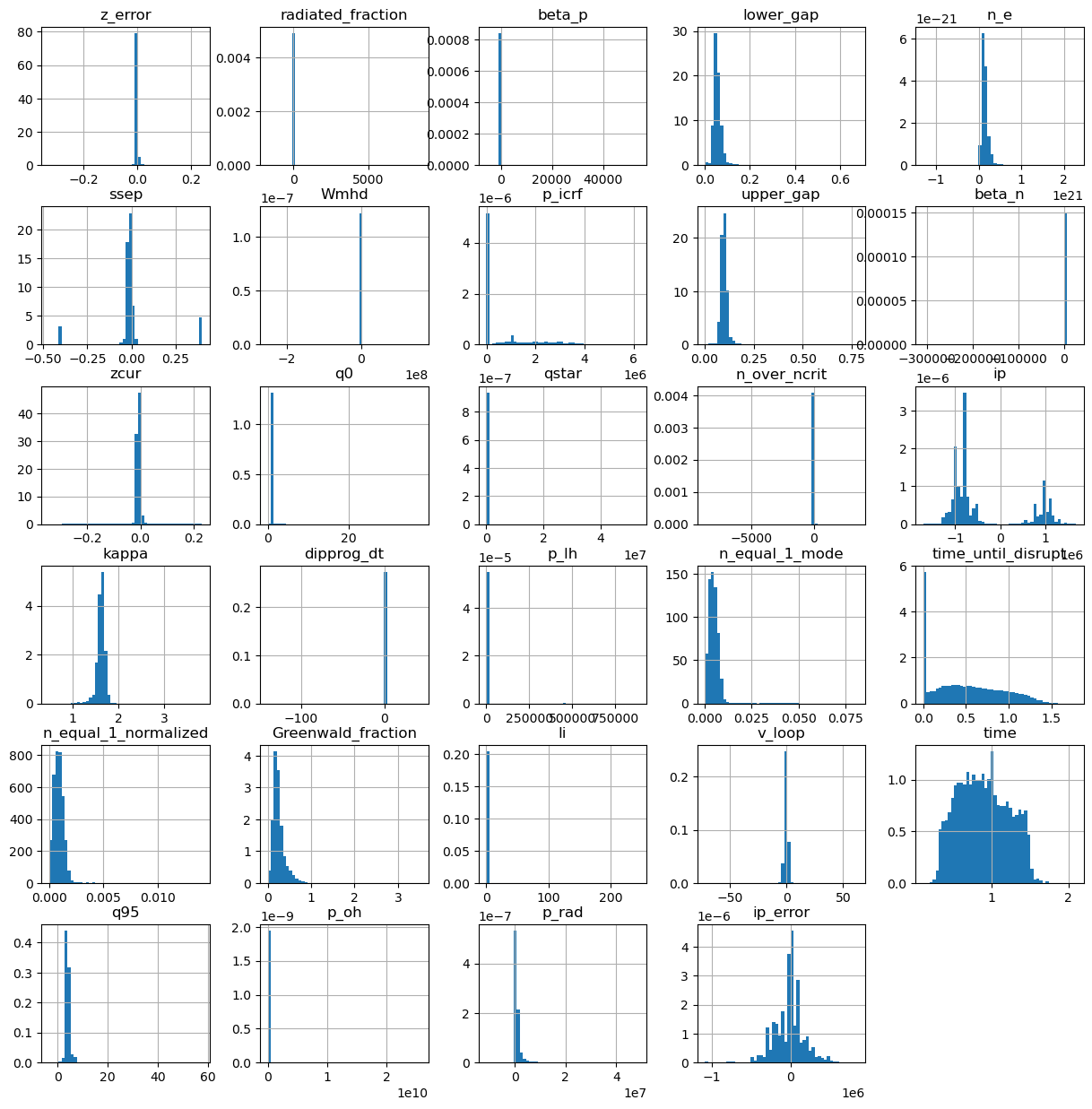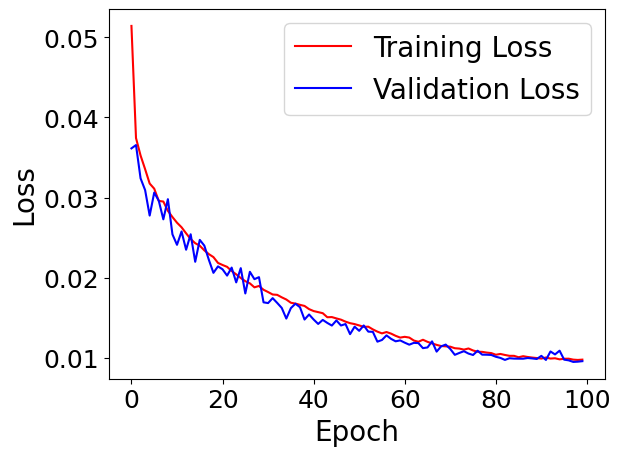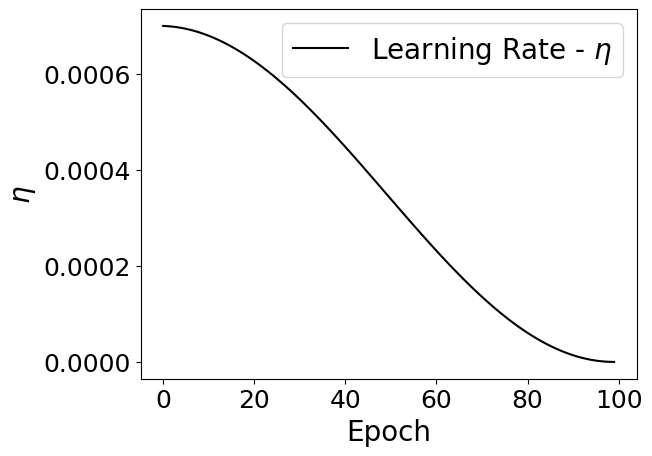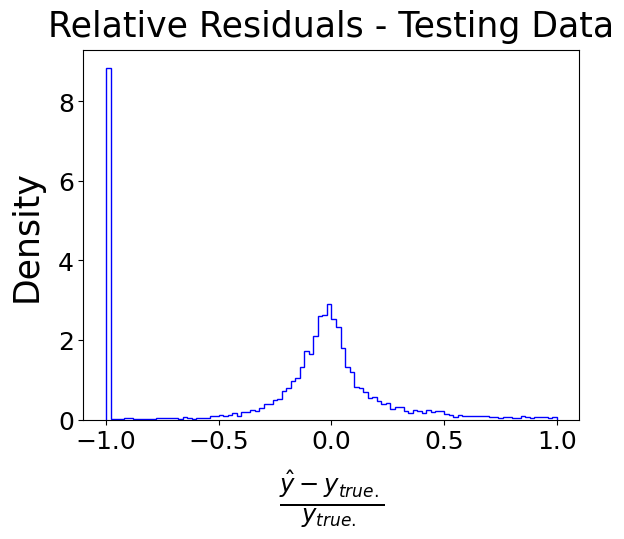Regression With Fusion Data#
The aim of this notebook is to regress the time until a disruption occurs given a current state in time.
In reality, our dataset is comprised of multiple shots, where each shot has individual time readings.
Shot Number |
Time Step |
Feature 1 |
Feature 2 |
|---|---|---|---|
1 |
\(t_0\) |
- |
- |
1 |
\(t_1\) |
- |
- |
1 |
\(t_2\) |
- |
- |
1 |
… |
- |
- |
1 |
\(t_m\) |
- |
- |
… |
|||
Shot Number |
Time Step |
Feature 1 |
Feature 2 |
—————– |
———————- |
—————– |
—————– |
N |
\(t_0\) |
- |
- |
N |
\(t_1\) |
- |
- |
N |
\(t_2\) |
- |
- |
N |
… |
- |
- |
N |
\(t_m\) |
- |
- |
In good approximation, we can treat individual readings in time as independent measurements and regress directly upon them.
You can think of this as a sort of state estimation:
Given state \(S_i\), independent of \(S_{j \neq i}\), we want to regress how long the stability of our fusion process will last.
Lets load our data and take a look at the features. We also need to drop some features as these will bias the regression.
We will drop:
Disruptive - this is a binary label indicating whether or not a disruption has occured.
Shot - this is an indexing variable for individual shots.
import pandas as pd
import matplotlib.pyplot as plt
df = pd.read_csv("full_db-complete_classified_0.1s.csv",sep=',',index_col=None)
df_regression = df.drop(columns=['disruptive','shot']) # Drop disruptive - binary la
df_regression = df_regression[df.time_until_disrupt > 0]
df_regression = df_regression.sample(frac=1.0) # Random shuffle shots
df_regression.head()
| z_error | radiated_fraction | beta_p | lower_gap | n_e | ssep | Wmhd | p_icrf | upper_gap | beta_n | ... | time_until_disrupt | n_equal_1_normalized | Greenwald_fraction | li | v_loop | time | q95 | p_oh | p_rad | ip_error | |
|---|---|---|---|---|---|---|---|---|---|---|---|---|---|---|---|---|---|---|---|---|---|
| 148403 | -0.000308 | 0.348539 | 0.294560 | 0.049893 | 2.203347e+20 | -0.025936 | 21782.460938 | 3.840209e+01 | 0.093674 | 0.742089 | ... | 0.0160 | 0.001137 | 0.604698 | 1.259797 | -2.511963 | 1.0899 | 2.940394 | 1.125851e+06 | 392415.960065 | 271289.0625 |
| 169792 | 0.000219 | 0.018243 | 0.257212 | 0.078944 | 1.575422e+20 | -0.013643 | 44130.542969 | 3.537796e+06 | 0.103161 | 0.439488 | ... | 0.2849 | 0.001021 | 0.309502 | 1.414968 | -0.851196 | 1.4200 | 4.553412 | 4.030026e+05 | 71890.617371 | 104532.6250 |
| 275818 | 0.000992 | 0.415253 | 0.135165 | 0.044478 | 7.909377e+19 | -0.018565 | 23948.123047 | 3.787166e+01 | 0.097886 | 0.223583 | ... | 1.2241 | 0.000308 | 0.148950 | 1.505030 | -0.808014 | 0.5200 | 4.437774 | 8.496335e+05 | 352828.804445 | -13796.6875 |
| 44013 | 0.000420 | -0.329507 | 0.092925 | 0.052791 | 7.200679e+19 | 0.010766 | 26898.298828 | 1.013809e+02 | 0.087245 | 0.192169 | ... | 0.1745 | 0.000827 | 0.106209 | 1.382588 | 0.796661 | 0.6400 | 3.791784 | -1.451691e+06 | 478308.292191 | -234166.7500 |
| 22454 | 0.001223 | 0.350599 | 0.189295 | 0.055474 | 1.547137e+20 | -0.007201 | 53719.265625 | 7.274901e+05 | 0.108699 | 0.408583 | ... | 0.8579 | 0.000525 | 0.233198 | 1.368598 | -1.063354 | 0.6800 | 3.532992 | 1.178322e+06 | 668175.674777 | -209515.4375 |
5 rows × 29 columns
Lets visualize our data.
df_regression.hist(figsize=(15,15),bins=50,density=True)
array([[<AxesSubplot:title={'center':'z_error'}>,
<AxesSubplot:title={'center':'radiated_fraction'}>,
<AxesSubplot:title={'center':'beta_p'}>,
<AxesSubplot:title={'center':'lower_gap'}>,
<AxesSubplot:title={'center':'n_e'}>],
[<AxesSubplot:title={'center':'ssep'}>,
<AxesSubplot:title={'center':'Wmhd'}>,
<AxesSubplot:title={'center':'p_icrf'}>,
<AxesSubplot:title={'center':'upper_gap'}>,
<AxesSubplot:title={'center':'beta_n'}>],
[<AxesSubplot:title={'center':'zcur'}>,
<AxesSubplot:title={'center':'q0'}>,
<AxesSubplot:title={'center':'qstar'}>,
<AxesSubplot:title={'center':'n_over_ncrit'}>,
<AxesSubplot:title={'center':'ip'}>],
[<AxesSubplot:title={'center':'kappa'}>,
<AxesSubplot:title={'center':'dipprog_dt'}>,
<AxesSubplot:title={'center':'p_lh'}>,
<AxesSubplot:title={'center':'n_equal_1_mode'}>,
<AxesSubplot:title={'center':'time_until_disrupt'}>],
[<AxesSubplot:title={'center':'n_equal_1_normalized'}>,
<AxesSubplot:title={'center':'Greenwald_fraction'}>,
<AxesSubplot:title={'center':'li'}>,
<AxesSubplot:title={'center':'v_loop'}>,
<AxesSubplot:title={'center':'time'}>],
[<AxesSubplot:title={'center':'q95'}>,
<AxesSubplot:title={'center':'p_oh'}>,
<AxesSubplot:title={'center':'p_rad'}>,
<AxesSubplot:title={'center':'ip_error'}>, <AxesSubplot:>]],
dtype=object)

Preprocessing#
We will create a train test split for this dataset, using the traditional 70/15/15% split.
We are also going to add a flag for taking the logarithm of time.
from sklearn.preprocessing import MinMaxScaler
############# Important Flag ##############
log_time = False
###########################################
def create_train_test_split(dataset,log_time=False):
def return_x_y(dataframe,log_time=False):
x = dataframe.drop(columns=['time_until_disrupt']).to_numpy()
if log_time:
y = np.log(dataframe['time_until_disrupt'].values)
else:
y = dataframe['time_until_disrupt'].values
return x,y
Nt = int(0.7 * len(dataset))
train = dataset[:Nt]
test_val = dataset[Nt:]
Nv = int(0.5 *len(test_val))
val = test_val[:Nv]
test = test_val[Nv:]
print("Total dataset size: ",len(dataset))
print("Number of Training data points: ",len(train))
print("Number of Validation data points: ",len(val))
print("Number of Testing data points: ",len(test))
train_x,train_y = return_x_y(train,log_time)
val_x,val_y = return_x_y(val,log_time)
test_x,test_y = return_x_y(test,log_time)
return train_x,train_y,val_x,val_y,test_x,test_y
train_x,train_y,val_x,val_y,test_x,test_y = create_train_test_split(df_regression,log_time=log_time)
Total dataset size: 63501
Number of Training data points: 44450
Number of Validation data points: 9525
Number of Testing data points: 9526
Lets scale our data. Here we will use MinMax scaling on the interval (-1,1). You can experiment with other scaling such as StandardScalers (z-score normalization) if you wish.
feature_scaler = MinMaxScaler((-1,1))
feature_scaler.fit(df_regression.drop(columns=['time_until_disrupt']).to_numpy()) # Lets use global statistics for simplicity here.
x_train_scaled = feature_scaler.transform(train_x)
x_val_scaled = feature_scaler.transform(val_x)
x_test_scaled = feature_scaler.transform(test_x)
print("Features")
print("Training:",x_train_scaled.max(),x_train_scaled.min())
print("Validation:",x_val_scaled.max(),x_val_scaled.min())
print("Testing:",x_test_scaled.max(),x_test_scaled.min())
if log_time: # Declared above
target_scaler = MinMaxScaler((0,1))
target_scaler.fit(np.log(df_regression['time_until_disrupt'].values.reshape(-1,1))) # Using global statistics for simplicity here
y_train_scaled = target_scaler.transform(train_y.reshape(-1,1)).flatten()
y_val_scaled = target_scaler.transform(val_y.reshape(-1,1)).flatten()
y_test_scaled = target_scaler.transform(test_y.reshape(-1,1)).flatten()
else:
y_train_scaled = train_y.copy()
y_val_scaled = val_y.copy()
y_test_scaled = test_y.copy()
print(" ")
print("Targets")
print("Training:",y_train_scaled.max(),y_train_scaled.min())
print("Validation:",y_val_scaled.max(),y_val_scaled.min())
print("Testing:",y_test_scaled.max(),y_test_scaled.min())
Features
Training: 1.0000000000000004 -1.0000000000000002
Validation: 1.0 -1.0
Testing: 1.0000000000000002 -1.0
Targets
Training: 1.7724999487400055 0.0004999637603759
Validation: 1.7924999594688416 0.0001000165939331
Testing: 1.7524999380111694 0.0009999275207519
Model Definition#
We will use a simple Deep Neural Network (DNN), commonly referred to as a Multi-Layer Perceptron (MLP).
We are going to make this as explicit as possible for clarity. We could use nn.Sequential to package this more neatly if we so choose, and also be more dynamic in our model creation.
import torch
from torch import nn
from torch.nn import BatchNorm1d
class MLP(nn.Module):
def __init__(self,input_shape,output_shape):
super(MLP, self).__init__()
self.init_layer = nn.Linear(input_shape,64)
self.B0 = nn.BatchNorm1d(64)
self.L1 = nn.Linear(64,256)
self.B1 = nn.BatchNorm1d(256)
self.L2 = nn.Linear(256,512)
self.B2 = nn.BatchNorm1d(512)
self.L3 = nn.Linear(512,256)
self.B3 = nn.BatchNorm1d(256)
self.L4 = nn.Linear(256,128)
self.B4 = nn.BatchNorm1d(128)
self.output = nn.Linear(128,output_shape)
self.activation = nn.SELU()
self.output_activation = nn.ReLU()
def forward(self,x):
x = self.activation(self.B0(self.init_layer(x))) # SELU(BNorm(Linear(x)))
x = self.activation(self.B1(self.L1(x)))
x = self.activation(self.B2(self.L2(x)))
x = self.activation(self.B3(self.L3(x)))
x = self.activation(self.B4(self.L4(x)))
x = self.output_activation(self.output(x)).squeeze(1) # Time must be > 0, ReLU is good choice here.
return x
regressor = MLP(input_shape=x_train_scaled.shape[1],output_shape=1) # Singular output
print(regressor)
MLP(
(init_layer): Linear(in_features=28, out_features=64, bias=True)
(B0): BatchNorm1d(64, eps=1e-05, momentum=0.1, affine=True, track_running_stats=True)
(L1): Linear(in_features=64, out_features=256, bias=True)
(B1): BatchNorm1d(256, eps=1e-05, momentum=0.1, affine=True, track_running_stats=True)
(L2): Linear(in_features=256, out_features=512, bias=True)
(B2): BatchNorm1d(512, eps=1e-05, momentum=0.1, affine=True, track_running_stats=True)
(L3): Linear(in_features=512, out_features=256, bias=True)
(B3): BatchNorm1d(256, eps=1e-05, momentum=0.1, affine=True, track_running_stats=True)
(L4): Linear(in_features=256, out_features=128, bias=True)
(B4): BatchNorm1d(128, eps=1e-05, momentum=0.1, affine=True, track_running_stats=True)
(output): Linear(in_features=128, out_features=1, bias=True)
(activation): SELU()
(output_activation): ReLU()
)
Lets see if we get output.
regressor(torch.tensor(x_train_scaled[:3]).float())
tensor([1.1473, 0.0000, 0.0000], grad_fn=<SqueezeBackward1>)
We are going to use built in pytorch functions for creating our data loading pipeline. Since we have simple tabular data, we can use TensorDataset(x,y).
Note that we are going to need to convert these numpy arrays to torch.tensor() objects first.
from torch.utils.data import TensorDataset, DataLoader
train_dataset = TensorDataset(torch.tensor(x_train_scaled),torch.tensor(y_train_scaled))
val_dataset = TensorDataset(torch.tensor(x_val_scaled),torch.tensor(y_val_scaled))
test_dataset = TensorDataset(torch.tensor(x_test_scaled),torch.tensor(y_test_scaled))
We can also build custom datasets, which you will see in next weeks lectures on normalizing flows. We will explain in more detail how those work then, but for now you should have knowledge of the basic method of getting data from these objects.
train_dataset.__getitem__(0)
(tensor([ 0.1039, -0.6623, 0.1553, -0.8241, -0.2839, 0.0161, -0.5669, -0.9937,
-0.7154, 0.4758, 0.1006, -0.9606, -0.5235, -0.7937, -0.3066, 0.1707,
0.5250, -0.9998, -0.8750, -0.7934, -0.3216, -0.0954, 0.0335, -0.0196,
-0.6106, -0.5459, -0.9736, 0.4466], dtype=torch.float64),
tensor(0.0160, dtype=torch.float64))
All pytorch datasets must have a getitem() function. This will be imporant when we want to pass these objects to a DataLoader(). Again, we will go into more detail on all of this next week. But lets get familiar with the basic usage.
We know that when we train deep learning models we will use batches of inputs to compute gradients. An efficient way to batch your data is to use the DataLoader() functions from pytorch. This will pass a series of random indices to your TensorDataset’s getitem() function and form batches.
train_loader = DataLoader(train_dataset,batch_size=10)
for i,data in enumerate(train_loader):
x = data[0]
y = data[1]
print("Batch {0}".format(i),"-> x shape: ",x.shape," y shape: ",y.shape)
break
Batch 0 -> x shape: torch.Size([10, 28]) y shape: torch.Size([10])
Now lets create a function to return dataloaders for the three datasets we have created.
# Create dataloaders to iterate.
# We take as input the three TensorDatasets along with the batch sizes we want to use.
def CreateLoaders(train_dataset,val_dataset,test_dataset,train_batch,val_batch,test_batch):
train_loader = DataLoader(train_dataset,
batch_size=train_batch,
shuffle=True)
val_loader = DataLoader(val_dataset,
batch_size=val_batch,
shuffle=False)
test_loader = DataLoader(test_dataset,
batch_size=val_batch,
shuffle=False)
return train_loader,val_loader,test_loader
train_loader,val_loader,test_loader = CreateLoaders(train_dataset,val_dataset,test_dataset,10,10,10)
Training Function#
We almost have everything we need to start training our model.
Datasets in a pytorch format.
DataLoaders for batch creation.
A training function - lets build this.
Lets write the training function in such a way that we can use it for any network.
There are two main components:
Training loop
Validation loop
We also need a clever way to store our parameters. Lets use a dictionary to do this.
Note that we are going to assume GPU usage here, so use your notebook on sciclone!
You can see the information regarding your GPU with the command below:
!nvidia-smi
Wed Jun 5 10:27:28 2024
+-----------------------------------------------------------------------------------------+
| NVIDIA-SMI 551.68 Driver Version: 551.68 CUDA Version: 12.4 |
|-----------------------------------------+------------------------+----------------------+
| GPU Name TCC/WDDM | Bus-Id Disp.A | Volatile Uncorr. ECC |
| Fan Temp Perf Pwr:Usage/Cap | Memory-Usage | GPU-Util Compute M. |
| | | MIG M. |
|=========================================+========================+======================|
| 0 NVIDIA GeForce RTX 4090 WDDM | 00000000:01:00.0 On | Off |
| 0% 34C P8 19W / 450W | 2156MiB / 24564MiB | 6% Default |
| | | N/A |
+-----------------------------------------+------------------------+----------------------+
+-----------------------------------------------------------------------------------------+
| Processes: |
| GPU GI CI PID Type Process name GPU Memory |
| ID ID Usage |
|=========================================================================================|
| 0 N/A N/A 5640 C+G ...oogle\Chrome\Application\chrome.exe N/A |
| 0 N/A N/A 5756 C+G ...5n1h2txyewy\ShellExperienceHost.exe N/A |
| 0 N/A N/A 6936 C+G ...ems\FX\SubAgent\AlienFXSubAgent.exe N/A |
| 0 N/A N/A 8076 C+G C:\Windows\explorer.exe N/A |
| 0 N/A N/A 8160 C ...James\.conda\envs\ptorch\python.exe N/A |
| 0 N/A N/A 9568 C+G ...nt.CBS_cw5n1h2txyewy\SearchHost.exe N/A |
| 0 N/A N/A 9592 C+G ...2txyewy\StartMenuExperienceHost.exe N/A |
| 0 N/A N/A 12132 C+G ...t.LockApp_cw5n1h2txyewy\LockApp.exe N/A |
| 0 N/A N/A 17240 C+G ...Programs\Microsoft VS Code\Code.exe N/A |
| 0 N/A N/A 23292 C+G ...__8wekyb3d8bbwe\WindowsTerminal.exe N/A |
| 0 N/A N/A 31464 C+G ...siveControlPanel\SystemSettings.exe N/A |
| 0 N/A N/A 31864 C+G ...ekyb3d8bbwe\PhoneExperienceHost.exe N/A |
| 0 N/A N/A 33840 C+G ...on\125.0.2535.85\msedgewebview2.exe N/A |
| 0 N/A N/A 37792 C+G ...wekyb3d8bbwe\XboxGameBarWidgets.exe N/A |
| 0 N/A N/A 42028 C+G ...crosoft\Edge\Application\msedge.exe N/A |
+-----------------------------------------------------------------------------------------+
If you don’t see an output with the above command please let me know and we will sort it.
config = {"seed":8,
"name": "MyRegressionModel",
"run_val":1,
"model": {
"input_shape":28,
"output_shape": 1,
},
"optimizer": {
"lr": 7e-4,
},
"num_epochs": 100,
"dataloader": {
"train": {
"batch_size": 64
},
"val": {
"batch_size": 64
},
"test": {
"batch_size": 64
},
},
"output": {
"dir":"./"
}
}
Below is our training function. It will operate as follows:
We set seeds for commonly used packages for reproducability.
Create a directory with name corresponding to the name field in the above dictionary.
We create our dataloaders - we only need train/val, but test will be created anyways and not used.
We create an instance of our MLP (funciton defined above)
We create an instance of an optimizer - Adam.
Define a learning rate scheduler - CosineAnnealing. We will see what this looks like graphically.
Define our loss function - SmoothL1Loss - https://pytorch.org/docs/stable/generated/torch.nn.SmoothL1Loss.html
For each epoch iterate over all batches in the training loader and train.
At the end of each epoch, iterate over the validation loader - DO NOT apply gradients.
import os
import json
import random
import pkbar
import torch.optim as optim
from torch.optim import lr_scheduler
import torch.nn as nn
import datetime
import shutil
import time
def trainer(config,train_dataset,val_dataset,test_dataset):
# Setup random seed
torch.manual_seed(config['seed'])
np.random.seed(config['seed'])
random.seed(config['seed'])
torch.cuda.manual_seed(config['seed'])
# Create experiment name
exp_name = config['name']
print(exp_name)
# Create directory structure
output_folder = config['output']['dir']
output_path = os.path.join(output_folder,exp_name)
if os.path.exists(output_path):
timestamp = time.time()
dt_object = datetime.datetime.fromtimestamp(timestamp)
formatted_time = dt_object.strftime('%H_%M_%S')
output_path = output_path +"_"+ str(formatted_time)
os.mkdir(output_path)
with open(os.path.join(output_path,'config.json'),'w') as outfile:
json.dump(config, outfile)
# Load the dataset
print('Creating Loaders.')
train_batch_size = config['dataloader']['train']['batch_size']
val_batch_size = config['dataloader']['val']['batch_size']
test_batch_size = config['dataloader']['val']['batch_size']
train_loader,val_loader,test_loader = CreateLoaders(train_dataset,val_dataset,test_dataset,train_batch_size,val_batch_size,test_batch_size)
history = {'train_loss':[],'val_loss':[],'lr':[]}
print("Training Size: {0}".format(len(train_loader.dataset)))
print("Validation Size: {0}".format(len(val_loader.dataset)))
# Create the model
input_shape = config['model']['input_shape']
output_shape = config['model']['output_shape']
net = MLP(input_shape=input_shape,output_shape=output_shape)
t_params = sum(p.numel() for p in net.parameters())
print("Network Parameters: ",t_params)
device = torch.device('cuda')
net.to('cuda')
# Optimizer
num_epochs=int(config['num_epochs'])
lr = float(config['optimizer']['lr'])
optimizer = optim.Adam(list(filter(lambda p: p.requires_grad, net.parameters())), lr=lr)
num_steps = len(train_loader) * num_epochs
scheduler = torch.optim.lr_scheduler.CosineAnnealingLR(optimizer=optimizer, T_max=num_steps, last_epoch=-1,
eta_min=0)
startEpoch = 0
global_step = 0
print('=========== Optimizer ==================:')
print(' LR:', lr)
print(' num_epochs:', num_epochs)
print('')
# Loss Function
loss_function = nn.SmoothL1Loss()
for epoch in range(startEpoch,num_epochs):
kbar = pkbar.Kbar(target=len(train_loader), epoch=epoch, num_epochs=num_epochs, width=20, always_stateful=False)
net.train()
running_loss = 0.0
for i, data in enumerate(train_loader):
input = data[0].to('cuda').float()
y = data[1].to('cuda').float()
optimizer.zero_grad()
with torch.set_grad_enabled(True):
y_hat = net(input)
loss = loss_function(y,y_hat)
loss.backward()
#torch.nn.utils.clip_grad_norm_(net.parameters(), max_norm=0.5,error_if_nonfinite=True)
optimizer.step()
scheduler.step()
running_loss += loss.item() * input.shape[0]
kbar.update(i, values=[("loss", loss.item())])
global_step += 1
history['train_loss'].append(running_loss / len(train_loader.dataset))
history['lr'].append(scheduler.get_last_lr()[0])
######################
## validation phase ##
######################
if bool(config['run_val']):
net.eval()
val_loss = 0.0
with torch.no_grad():
for i, data in enumerate(val_loader):
input = data[0].to('cuda').float()
y = data[1].to('cuda').float()
y_hat = net(input)
loss = loss_function(y,y_hat)
val_loss += loss
val_loss = val_loss.cpu().numpy() / len(val_loader)
history['val_loss'].append(val_loss)
kbar.add(1, values=[("val_loss", val_loss.item())])
name_output_file = config['name']+'_epoch{:02d}_val_loss_{:.6f}.pth'.format(epoch, val_loss)
else:
kbar.add(1,values=[('val_loss',0.)])
name_output_file = config['name']+'_epoch{:02d}_train_loss_{:.6f}.pth'.format(epoch, running_loss / len(train_loader.dataset))
filename = os.path.join(output_path, name_output_file)
checkpoint={}
checkpoint['net_state_dict'] = net.state_dict()
checkpoint['optimizer'] = optimizer.state_dict()
checkpoint['scheduler'] = scheduler.state_dict()
checkpoint['epoch'] = epoch
checkpoint['history'] = history
checkpoint['global_step'] = global_step
torch.save(checkpoint,filename)
print('')
trainer(config,train_dataset,val_dataset,test_dataset)
MyRegressionModel
Creating Loaders.
Training Size: 44450
Validation Size: 9525
Network Parameters: 316865
=========== Optimizer ==================:
LR: 0.0007
num_epochs: 100
Epoch: 1/100
695/695 [====================] - 5s 7ms/step - loss: 0.0512 - val_loss: 0.0361
Epoch: 2/100
695/695 [====================] - 8s 11ms/step - loss: 0.0374 - val_loss: 0.0366
Epoch: 3/100
695/695 [====================] - 8s 11ms/step - loss: 0.0353 - val_loss: 0.0324
Epoch: 4/100
695/695 [====================] - 8s 11ms/step - loss: 0.0336 - val_loss: 0.0309
Epoch: 5/100
695/695 [====================] - 8s 11ms/step - loss: 0.0318 - val_loss: 0.0278
Epoch: 6/100
695/695 [====================] - 8s 11ms/step - loss: 0.0311 - val_loss: 0.0306
Epoch: 7/100
695/695 [====================] - 8s 11ms/step - loss: 0.0296 - val_loss: 0.0296
Epoch: 8/100
695/695 [====================] - 7s 11ms/step - loss: 0.0295 - val_loss: 0.0273
Epoch: 9/100
695/695 [====================] - 8s 11ms/step - loss: 0.0284 - val_loss: 0.0298
Epoch: 10/100
695/695 [====================] - 8s 11ms/step - loss: 0.0276 - val_loss: 0.0254
Epoch: 11/100
695/695 [====================] - 8s 11ms/step - loss: 0.0269 - val_loss: 0.0241
Epoch: 12/100
695/695 [====================] - 8s 11ms/step - loss: 0.0263 - val_loss: 0.0258
Epoch: 13/100
695/695 [====================] - 8s 11ms/step - loss: 0.0255 - val_loss: 0.0235
Epoch: 14/100
695/695 [====================] - 8s 11ms/step - loss: 0.0248 - val_loss: 0.0254
Epoch: 15/100
695/695 [====================] - 8s 11ms/step - loss: 0.0243 - val_loss: 0.0220
Epoch: 16/100
695/695 [====================] - 7s 11ms/step - loss: 0.0240 - val_loss: 0.0247
Epoch: 17/100
695/695 [====================] - 8s 11ms/step - loss: 0.0234 - val_loss: 0.0240
Epoch: 18/100
695/695 [====================] - 8s 11ms/step - loss: 0.0230 - val_loss: 0.0222
Epoch: 19/100
695/695 [====================] - 8s 11ms/step - loss: 0.0226 - val_loss: 0.0206
Epoch: 20/100
695/695 [====================] - 8s 11ms/step - loss: 0.0219 - val_loss: 0.0214
Epoch: 21/100
695/695 [====================] - 8s 11ms/step - loss: 0.0216 - val_loss: 0.0211
Epoch: 22/100
695/695 [====================] - 7s 11ms/step - loss: 0.0214 - val_loss: 0.0203
Epoch: 23/100
695/695 [====================] - 8s 11ms/step - loss: 0.0208 - val_loss: 0.0213
Epoch: 24/100
695/695 [====================] - 8s 11ms/step - loss: 0.0204 - val_loss: 0.0194
Epoch: 25/100
695/695 [====================] - 8s 11ms/step - loss: 0.0200 - val_loss: 0.0212
Epoch: 26/100
695/695 [====================] - 7s 11ms/step - loss: 0.0196 - val_loss: 0.0180
Epoch: 27/100
695/695 [====================] - 8s 11ms/step - loss: 0.0193 - val_loss: 0.0208
Epoch: 28/100
695/695 [====================] - 7s 11ms/step - loss: 0.0188 - val_loss: 0.0198
Epoch: 29/100
695/695 [====================] - 8s 11ms/step - loss: 0.0190 - val_loss: 0.0201
Epoch: 30/100
695/695 [====================] - 8s 11ms/step - loss: 0.0185 - val_loss: 0.0169
Epoch: 31/100
695/695 [====================] - 8s 11ms/step - loss: 0.0182 - val_loss: 0.0168
Epoch: 32/100
695/695 [====================] - 7s 11ms/step - loss: 0.0179 - val_loss: 0.0175
Epoch: 33/100
695/695 [====================] - 8s 11ms/step - loss: 0.0179 - val_loss: 0.0169
Epoch: 34/100
695/695 [====================] - 8s 11ms/step - loss: 0.0175 - val_loss: 0.0162
Epoch: 35/100
695/695 [====================] - 8s 11ms/step - loss: 0.0173 - val_loss: 0.0149
Epoch: 36/100
695/695 [====================] - 8s 11ms/step - loss: 0.0169 - val_loss: 0.0162
Epoch: 37/100
695/695 [====================] - 8s 11ms/step - loss: 0.0168 - val_loss: 0.0168
Epoch: 38/100
695/695 [====================] - 8s 11ms/step - loss: 0.0166 - val_loss: 0.0163
Epoch: 39/100
695/695 [====================] - 7s 11ms/step - loss: 0.0165 - val_loss: 0.0148
Epoch: 40/100
695/695 [====================] - 8s 11ms/step - loss: 0.0161 - val_loss: 0.0154
Epoch: 41/100
695/695 [====================] - 8s 11ms/step - loss: 0.0159 - val_loss: 0.0148
Epoch: 42/100
695/695 [====================] - 7s 11ms/step - loss: 0.0157 - val_loss: 0.0142
Epoch: 43/100
695/695 [====================] - 8s 11ms/step - loss: 0.0156 - val_loss: 0.0147
Epoch: 44/100
695/695 [====================] - 8s 11ms/step - loss: 0.0151 - val_loss: 0.0144
Epoch: 45/100
695/695 [====================] - 8s 11ms/step - loss: 0.0151 - val_loss: 0.0140
Epoch: 46/100
695/695 [====================] - 8s 11ms/step - loss: 0.0149 - val_loss: 0.0147
Epoch: 47/100
695/695 [====================] - 8s 11ms/step - loss: 0.0148 - val_loss: 0.0141
Epoch: 48/100
695/695 [====================] - 8s 11ms/step - loss: 0.0145 - val_loss: 0.0142
Epoch: 49/100
695/695 [====================] - 8s 11ms/step - loss: 0.0143 - val_loss: 0.0130
Epoch: 50/100
695/695 [====================] - 8s 11ms/step - loss: 0.0142 - val_loss: 0.0139
Epoch: 51/100
695/695 [====================] - 8s 11ms/step - loss: 0.0141 - val_loss: 0.0134
Epoch: 52/100
695/695 [====================] - 8s 11ms/step - loss: 0.0139 - val_loss: 0.0141
Epoch: 53/100
695/695 [====================] - 8s 11ms/step - loss: 0.0139 - val_loss: 0.0133
Epoch: 54/100
695/695 [====================] - 8s 11ms/step - loss: 0.0136 - val_loss: 0.0133
Epoch: 55/100
695/695 [====================] - 8s 11ms/step - loss: 0.0133 - val_loss: 0.0120
Epoch: 56/100
695/695 [====================] - 8s 11ms/step - loss: 0.0131 - val_loss: 0.0122
Epoch: 57/100
695/695 [====================] - 8s 11ms/step - loss: 0.0132 - val_loss: 0.0128
Epoch: 58/100
695/695 [====================] - 8s 11ms/step - loss: 0.0130 - val_loss: 0.0124
Epoch: 59/100
695/695 [====================] - 7s 11ms/step - loss: 0.0128 - val_loss: 0.0121
Epoch: 60/100
695/695 [====================] - 8s 11ms/step - loss: 0.0125 - val_loss: 0.0122
Epoch: 61/100
695/695 [====================] - 8s 11ms/step - loss: 0.0126 - val_loss: 0.0119
Epoch: 62/100
695/695 [====================] - 7s 11ms/step - loss: 0.0125 - val_loss: 0.0117
Epoch: 63/100
695/695 [====================] - 8s 11ms/step - loss: 0.0122 - val_loss: 0.0119
Epoch: 64/100
695/695 [====================] - 8s 11ms/step - loss: 0.0120 - val_loss: 0.0119
Epoch: 65/100
695/695 [====================] - 8s 11ms/step - loss: 0.0123 - val_loss: 0.0112
Epoch: 66/100
695/695 [====================] - 8s 11ms/step - loss: 0.0120 - val_loss: 0.0113
Epoch: 67/100
695/695 [====================] - 8s 11ms/step - loss: 0.0118 - val_loss: 0.0121
Epoch: 68/100
695/695 [====================] - 8s 11ms/step - loss: 0.0116 - val_loss: 0.0108
Epoch: 69/100
695/695 [====================] - 8s 11ms/step - loss: 0.0115 - val_loss: 0.0115
Epoch: 70/100
695/695 [====================] - 8s 11ms/step - loss: 0.0115 - val_loss: 0.0117
Epoch: 71/100
695/695 [====================] - 8s 11ms/step - loss: 0.0114 - val_loss: 0.0111
Epoch: 72/100
695/695 [====================] - 8s 11ms/step - loss: 0.0112 - val_loss: 0.0104
Epoch: 73/100
695/695 [====================] - 8s 11ms/step - loss: 0.0112 - val_loss: 0.0106
Epoch: 74/100
695/695 [====================] - 7s 11ms/step - loss: 0.0110 - val_loss: 0.0108
Epoch: 75/100
695/695 [====================] - 8s 11ms/step - loss: 0.0112 - val_loss: 0.0105
Epoch: 76/100
695/695 [====================] - 8s 11ms/step - loss: 0.0109 - val_loss: 0.0104
Epoch: 77/100
695/695 [====================] - 8s 11ms/step - loss: 0.0108 - val_loss: 0.0109
Epoch: 78/100
695/695 [====================] - 8s 11ms/step - loss: 0.0108 - val_loss: 0.0104
Epoch: 79/100
695/695 [====================] - 8s 11ms/step - loss: 0.0107 - val_loss: 0.0104
Epoch: 80/100
695/695 [====================] - 8s 11ms/step - loss: 0.0106 - val_loss: 0.0104
Epoch: 81/100
695/695 [====================] - 8s 11ms/step - loss: 0.0104 - val_loss: 0.0102
Epoch: 82/100
695/695 [====================] - 8s 11ms/step - loss: 0.0105 - val_loss: 0.0100
Epoch: 83/100
695/695 [====================] - 8s 11ms/step - loss: 0.0104 - val_loss: 0.0098
Epoch: 84/100
695/695 [====================] - 8s 11ms/step - loss: 0.0102 - val_loss: 0.0100
Epoch: 85/100
695/695 [====================] - 8s 11ms/step - loss: 0.0103 - val_loss: 0.0099
Epoch: 86/100
695/695 [====================] - 8s 11ms/step - loss: 0.0101 - val_loss: 0.0099
Epoch: 87/100
695/695 [====================] - 7s 11ms/step - loss: 0.0102 - val_loss: 0.0099
Epoch: 88/100
695/695 [====================] - 8s 11ms/step - loss: 0.0101 - val_loss: 0.0100
Epoch: 89/100
695/695 [====================] - 8s 11ms/step - loss: 0.0101 - val_loss: 0.0099
Epoch: 90/100
695/695 [====================] - 7s 11ms/step - loss: 0.0100 - val_loss: 0.0099
Epoch: 91/100
695/695 [====================] - 8s 11ms/step - loss: 0.0099 - val_loss: 0.0103
Epoch: 92/100
695/695 [====================] - 8s 11ms/step - loss: 0.0101 - val_loss: 0.0098
Epoch: 93/100
695/695 [====================] - 7s 11ms/step - loss: 0.0099 - val_loss: 0.0108
Epoch: 94/100
695/695 [====================] - 8s 11ms/step - loss: 0.0100 - val_loss: 0.0104
Epoch: 95/100
695/695 [====================] - 8s 11ms/step - loss: 0.0098 - val_loss: 0.0109
Epoch: 96/100
695/695 [====================] - 8s 11ms/step - loss: 0.0099 - val_loss: 0.0098
Epoch: 97/100
695/695 [====================] - 8s 11ms/step - loss: 0.0099 - val_loss: 0.0097
Epoch: 98/100
695/695 [====================] - 8s 11ms/step - loss: 0.0098 - val_loss: 0.0095
Epoch: 99/100
695/695 [====================] - 8s 11ms/step - loss: 0.0098 - val_loss: 0.0095
Epoch: 100/100
695/695 [====================] - 8s 11ms/step - loss: 0.0098 - val_loss: 0.0096
Lets take a look at what the learning rate scheduler has done for us:
dicte = torch.load(os.path.join(config['name'],os.listdir("MyRegressionModel")[-1]))
print(dicte.keys())
dict_keys(['net_state_dict', 'optimizer', 'scheduler', 'epoch', 'history', 'global_step'])
Within each .pth file, we have stored the weights at a specific epoch, along with a variety of other useful information. First lets plot the training and validation losses, along with the learning rate.
train_loss = dicte['history']['train_loss']
val_loss = dicte['history']['val_loss']
learning_rate = dicte['history']['lr']
plt.plot(train_loss,'r-',label="Training Loss")
plt.plot(val_loss,'b-',label='Validation Loss')
plt.legend(fontsize=20)
plt.xlabel('Epoch',fontsize=20)
plt.ylabel('Loss',fontsize=20)
plt.tick_params(axis='both', labelsize=18)
plt.show()
plt.plot(learning_rate,'k-',label=r"Learning Rate - $\eta$")
plt.legend(fontsize=20)
plt.xlabel('Epoch',fontsize=20)
plt.ylabel(r'$\eta$',fontsize=20)
plt.tick_params(axis='both', labelsize=18)
plt.show()


Notice how we have decreased the learning rate at each step corresponding to a cosine distribution. Specifically, we follow the formula below:
\(\eta_{t} = \eta_{\text{min}} + \frac{1}{2} (\eta_{\text{max}} - \eta_{\text{min}}) \left(1 + \cos\left(\frac{T_{\text{cur}}}{T_{\text{max}}} \pi\right)\right)\)
\(\eta_{t+1} = \eta_{t} + \frac{1}{2} (\eta_{\text{max}} - \eta_{\text{min}}) \left(1 - \cos\left(\frac{T_{\text{cur}}}{T_{\text{max}}} \pi\right)\right)\)
where:
\(\eta_{t}\) is the learning rate at time (t),
\(\eta_{t+1}\) is the learning rate at time (t+1),
\(\eta_{\text{min}}\) is the minimum learning rate,
\(\eta_{\text{max}}\) is the maximum learning rate,
\(T_{\text{cur}}\) is the current time step,
\(T_{\text{max}}\) is the maximum time step.
with \(T_{\text{cur}} \neq (2k+1)T_{\text{max}}\),
and \( T_{\text{cur}} = (2k+1)T_{\text{max}}. \)
Testing the Performance#
We have trained our model, and at each epoch we have saved the weights of the model to .pth file. This will be located in a folder corresponding to the “name” field of the config dictionary.
Lets load in the model, and look at some metrics.
input_shape = config['model']['input_shape']
output_shape = config['model']['output_shape']
net = MLP(input_shape=input_shape,output_shape=output_shape)
t_params = sum(p.numel() for p in net.parameters())
print("Network Parameters: ",t_params)
device = torch.device('cuda')
net.to('cuda')
dicte = torch.load(os.path.join(config['name'],os.listdir("MyRegressionModel")[-1]))
net.load_state_dict(dicte["net_state_dict"])
Network Parameters: 316865
<All keys matched successfully>
test_loader = DataLoader(test_dataset,batch_size=config['dataloader']['test']['batch_size'])
net.eval() # Eval mode
predictions = []
y_true = []
kbar = pkbar.Kbar(target=len(test_loader), width=20, always_stateful=False)
for i,data in enumerate(test_loader):
x = data[0].to('cuda').float()
with torch.set_grad_enabled(False): # Same as with torch.no_grad():
y_hat = net(x).detach().cpu().numpy()
if log_time: # Decalared above
y_hat = np.exp(target_scaler.inverse_transform(y_hat.reshape(-1,1))).flatten()
y_true.append(np.exp(target_scaler.inverse_transform(data[1].numpy().reshape(-1,1))).flatten())
else:
y_true.append(data[1].numpy())
predictions.append(y_hat)
kbar.update(i)
predictions = np.concatenate(predictions)
y_true = np.concatenate(y_true)
127/149 [================>...] - ETA: 0s
Lets look at the relative residuals.
relative_residuals = (predictions - y_true) / (y_true + 1e-7)
plt.hist(relative_residuals,density=True,color='blue',histtype='step',label='Relative Residuals',range=[-1,1],bins=100)
plt.title('Relative Residuals - Testing Data',fontsize=25,pad=10)
plt.xlabel(r'$\frac{\hat{y} - y_{true.}}{y_{true.}}$',fontsize=25,labelpad=10)
plt.ylabel('Density',fontsize=25,labelpad=10)
plt.tick_params(axis='both', labelsize=18)

Uh oh. We have a large spike at -1. Can anyone hypothesize why this could be the case?
Can you look into the predicted and true values to get some intuition?


